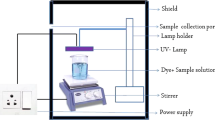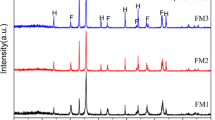Abstract
Hydrogen titanate (H2Ti3O7) nanotubes/nanosheets (HTN) are emerging class of adsorbent material which possess unique property of activating hydrogen peroxide (H2O2) to generate the reactive oxygen species (ROS), such as superoxide radical ions (O2 .−) and hydroxyl radicals (·OH), effective in the decomposition of surface-adsorbed dye. However, HTN are non-magnetic which create hurdle in their effective separation from the treated aqueous solution. To overcome this issue, magnetic nanocomposites (HTNF) composed of HTN and maghemite (γ-Fe2O3) nanoparticles have been processed by subjecting the core–shell magnetic photocatalyst consisting of γ-Fe2O3/silica (SiO2)/titania (TiO2), having varying amounts of TiO2 in the shell to the hydrothermal conditions. HTNF-5 magnetic nanocomposite consisting of 31 wt% H2Ti3O7, typically having nanotube morphology with the highest specific surface area (133 m2 g−1) and pore-volume (0.22 cm3 g−1), exhibits the highest capacity (74 mg g−1) for the adsorption of cationic methylene blue (MB) dye from an aqueous solution involving the electrostatic attraction mechanism and pseudo-second-order kinetics. Very fast magnetic separation followed by regeneration of HTNF-5 magnetic nanocomposite has been demonstrated via non-radiation driven H2O2 activation. It has been ascertained for the first time that the underlying mechanism of dye decomposition involves the synergy effect between the constituents of HTNF magnetic nanocomposite.











Similar content being viewed by others
Abbreviations
- AP:
-
3-Aminophthalate
- BET:
-
Brunauer–Emmett–Teller
- BJH:
-
Barrett–Joyner–Halenda
- DKR:
-
Dubinin–Kaganer–Radushkevich
- DTA:
-
Differential thermal analysis
- EDTA:
-
Ethylenediaminetetraacetic acid
- EDX:
-
Energy dispersive X-ray
- EPR:
-
Electron paramagnetic resonance
- FTIR:
-
Fourier transform infrared
- HRTEM:
-
High-resolution transmission electron microscope
- HTN:
-
Hydrogen titanate nanotubes/nanosheets
- HTNF:
-
Hydrogen titanate nanotubes/nanosheets-maghemite
- JCPDS:
-
Joint Committee on Powder Diffraction Standards
- MB:
-
Methylene blue
- PL:
-
Photoluminescence
- PPMS:
-
Physical property measurement system
- ROS:
-
Reactive oxygen species
- SAED:
-
Selected area electron diffraction
- SS:
-
Stainless steel
- SSA:
-
Specific surface area
- STA:
-
Simultaneous thermal analyzer
- TA:
-
Terephthalic acid
- TEM:
-
Transmission electron microscope
- TG:
-
Thermal gravimetry
- TSF:
-
Maghemite/silica/titania
- UV:
-
Ultraviolet
- VSM:
-
Vibrating sample magnetometer
- XPS:
-
X-ray photoelectron spectroscope
- XRD:
-
X-ray diffraction
References
Abramson S, Srithammavanh L, Siaugue JM, Horner O, Xu X, Cabuil V (2009) Nanometric core-shell-shell γ-Fe2O3/SiO2/TiO2 particles. J Nanopart Res 11:459–465
Babu KB, Warrier KG, Shukla S (2014) Decolorization of aqueous solution containing organic synthetic-dye via dark-catalysis process using hydrothermally synthesized semiconductor-oxides nanotubes. Adv Sci Eng Med 6:173–183
Bavykin DV, Friedrich JM, Lapkin AA, Walsh FC (2006) Stability of aqueous suspensions of titanate nanotubes. Chem Mater 18:1124–1129
Bavykin DV, Redmond KE, Nias BP, Kulak AN, Walsh FC (2010) The effect of ionic charge on the adsorption of organic dyes onto titanate nanotubes. Aust J Chem 63:270–275
Beydoun D, Amal R, Low G, McEvoy S (2002) Occurrence and prevention of photodissolution at the phase junction of magnetite and titanium dioxide. J Mol Catal A 180:193–200
Costa RC, Lelis M, Oliveira L, Fabris J, Ardisson JD, Rios R, Silva C, Lago R (2006) Novel active heterogeneous Fenton system based on Fe3−XMXO4 (Fe, Co, Mn, Ni): the role of M2+ species on the reactivity towards H2O2 reactions. J Hazard Mater 129:171–178
Freundlich H (1906) Over the adsorption in solution. J Phys Chem 57:385–470
Gracia-Espino E, Lopez-Urias F, Terrones H, Terrones M (2012) Novel nanocarbons for adsorption. In: Tascon JMD (ed) Novel carbon adsorbents. Elsevier, Amsterdam , pp 3–34Chapter 1
Gunathilake C, Kadanapitiye MS, Dudarko O, Huang SD, Jaroniec M (2015) Adsorption of lead ions from aqueous phase on mesoporous silica with P-containing pendant groups. ACS Appl Mater Interfaces 7:23144–23152
Gupta VK, Suhas (2009) Application of low-cost adsorbents for dye removal - a review. J Environ Manag 90:2313–2342
Haitham K, Razak S, Nawi M (2014) Kinetics and isotherm studies of methyl orange adsorption by a highly recyclable immobilized polyaniline on a glass plate. Arab J Chem. doi:10.1016/j.arabjc.2014.10.010
Hareesh P, Babitha KB, Shukla S (2012) Processing fly ash stabilized hydrogen titanate nano-sheets for industrial dye-removal application. J Hazard Mater 229-230:177–182
Harsha N, Krishna KVS, Renuka NK, Shukla S (2015) Facile synthesis of γ-Fe2O3 nanoparticles integrated H2Ti3O7 nanotubes structure as a magnetically recyclable dye-removal catalyst. RSC Adv 5:30354–30362
Ho YS, McKay G (1998) Sorption of dye from aqueous solution by peat. Chem Eng J 70:115–124
Houas A, Lachheb H, Ksibi M, Elaloui E, Guillard C, Herrmann JM (2001) Photocatalytic degradation pathway of methylene blue in water. Appl Catal B 31:145–157
Ishibashi KI, Fujishima A, Watanabe T, Hashimoto K (2000) Detection of active oxidative species in TiO2 photocatalysis using the fluorescence technique. Electrochem Commun 2:207–210
Jose M, Haridas MP, Shukla S (2014) Predicting dye-adsorption capacity of hydrogen titanate nanotubes via one-step dye-removal method of novel chemically-activated catalytic process conducted in dark. J Environ Chem Eng 2:1980–1988
Kitano M, Wada E, Nakajima K, Hayashi S, Miyazaki S, Kobayashi H, Hara M (2013) Protonated titanate nanotubes with Lewis and Brønsted acidity: relationship between nanotube structure and catalytic activity. Chem Mater 25:385–393
Konicki W, Sibera D, Mijowska E, Lendzion-Bieluń Z, Narkiewicz U (2013) Equilibrium and kinetic studies on acid dye acid red 88 adsorption by magnetic ZnFe2O4 spinel ferrite nanoparticles. J Colloid Interface Sci 398:152–160
Lagergren S (1898) About the theory of so-called adsorption of soluble substances. Kung Sven Veten Hand 24:1–39
Lakouraj MM, Norouzian RS, Balo S (2015) Preparation and cationic dye adsorption of novel Fe3O4 supermagnetic/thiacalix[4]arene tetrasulfonate self-doped/polyaniline nanocomposite: kinetics, isotherms, and thermodynamic study. J Chem Eng Data 60:2262–2272
Langmuir I (1916) The constitution and fundamental properties of solids and liquids part I. solids. J Am Chem Soc 38:2221–2295
Lee CK, Lin KS, Wu CF, Lyu MD, Lo CC (2008) Effects of synthesis temperature on the microstructures and basic dyes adsorption of titanate nanotubes. J Hazard Mater 150:494–503
Lee CK, Fen SK, Chao HP, Liu SS, Huang FC (2012) Effects of pore structure and surface chemical characteristics on the adsorption of organic vapors on titanate nanotubes. Adsorption 18:349–357
Li W, Deng Y, Wu Z, Qian X, Yang J, Wang Y, Gu D, Zhang F, Tu B, Zhao D (2011) Hydrothermal etching assisted crystallization: a facile route to functional yolk-shell titanate microspheres with ultrathin nanosheets-assembled double shells. J Am Chem Soc 133:15830–15833
Lin SH, Wang CH (2003) Adsorption and catalytic oxidation of phenol in a new ozone reactor. Environ Technol 24:1031–1039
Liu SQ (2012) Magnetic semiconductor nano-photocatalysts for the degradation of organic pollutants. Environ Chem Lett 10:209–216
Lorencon E, Brandao FD, Krambrock K, Alves DCB, Silva JCC, Ferlauto AS, Lago RM (2014) Generation of reactive oxygen species in titanates nanotubes induced by hydrogen peroxide and their application in catalytic degradation of methylene blue dye. J Mol Catal A 394:316–323
Lu H, Zhao J, Li L, Zheng J, Zhang L, Gong L, Wang Z, Zhu Z (2011) A systematic study on evolution mechanism of titanate nanostructures in the hydrothermal process. Chem Phys Lett 508:258–264
Narayani H, Arayapurath H, Shukla S (2013a) Significance of silica interlayer in magnetic photocatalyst having γ-Fe2O3 as a magnetic ceramic core. Sci Adv Mater 5:1060–1073
Narayani H, Kunniveetil SP, Shukla S (2013b) Effect of solution-pH on methylene blue dye adsorption on hydrogen titanate nanotubes processed via hydrothermal method. Adv Sci Eng Med 5:63–72
Nosaka Y, Yamashita Y, Fukuyama H (1997) Application of chemiluminescent probe to monitoring superoxide radicals and hydrogen peroxide in TiO2 photocatalysis. J Phys Chem B 101:5822–5827
Papa AL, Maurizi L, Vandroux D, Walker P, Millot N (2011) Synthesis of titanate nanotubes directly coated with USPIO in hydrothermal conditions: a new detectable nanocarrier. J Phys Chem C 115:19012–19017
Schneider J, Matsuoka M, Takeuchi M, Zhang J, Horiuchi Y, Anpo M, Bahnemann DW (2014) Understanding TiO2 photocatalysis: mechanisms and materials. Chem Rev 114:9919–9986
Shen S, Pan T, Liu X, Yuan L, Wang J, Zhang Y, Guo Z (2010) Adsorption of Rh(III) complexes from chloride solutions obtained by leaching chlorinated spent automotive catalysts on ion-exchange resin. J Hazard Mater 179:104–112
Shukla S, Oturan MA (2015) Dye removal using electrochemistry and semiconductor oxide nanotubes. Environ Chem Lett 13:157–172
Shukla SV, Warrier, KGK, Babu BK (2014) Publication Date: 20-February, World Intellectual Property Organization (WIPO) Publication Number WO/2014/027364
Sivashankar R, Sathya A, Vasantharaj K, Sivasubramanian V (2014) Magnetic composite an environmental super adsorbent for dye sequestration—a review. Environ Nanotechnol Monit Manage 1:36–49
Tan I, Ahmad AL, Hameed B (2008) Adsorption of basic dye on high-surface-area activated carbon prepared from coconut husk: equilibrium, kinetic and thermodynamic studies. J Hazard Mater 154:337–346
Teixeira TPF, Aquino SF, Pereira SI, Dias A (2014) Use of calcined layered double hydroxides for the removal of color and organic matter from textile effluents: kinetic, equilibrium and recycling studies. J Chem Eng 31:19–26
Thazhe L, Shereef A, Shukla S, Reshmi CP, Varma MR, Suresh KG, Patil K, Warrier KG (2010) Magnetic dye-adsorbent catalyst: processing, characterization, and application. J Am Ceram Soc 93:3642–3650
Wang C, Yin L, Zhang L, Kang L, Wang X, Gao R (2009) Magnetic (γ-Fe2O3@SiO2) N@TiO2 functional hybrid nanoparticles with actived photocatalytic ability. J Phys Chem 113:4008–4011
Wang C, Liu H, Sun Z (2012) Heterogeneous photo-Fenton reaction catalyzed by nanosized iron oxides for water treatment. Int J Photoenergy. doi:10.1155/2012/801694
Wang Q, Tian S, Ning P (2013) Degradation mechanism of methylene blue in a heterogeneous Fenton-like reaction catalyzed by ferrocene. Eng Chem Res 53:643–649
Wong C, Chu W (2003) The hydrogen peroxide-assisted photocatalytic degradation of alachlor in TiO2 suspensions. Environ Sci Technol 37:2310–2316
Wu D, Liu J, Zhao X, Li A, Chen Y, Ming N (2006) Sequence of events for the formation of titanate nanotubes, nanofibers, nanowires, and nanobelts. Chem Mater 18:547–553
Yu X, Liu S, Yu J (2011) Superparamagnetic γ-Fe2O3@SiO2@TiO2 composite microspheres with superior photocatalytic properties. Appl Catal B 104:12–20
Zhang YR, Wang SQ, Shen SL, Zhao BX (2013) A novel water treatment magnetic nanomaterial for removal of anionic and cationic dyes under severe condition. Chem Eng J 233:258–264
Zhou L, Xu M, Wei G, Li L, Chubik M, Chubik MP, Gromov AA, Han W (2015a) Fe3O4@titanate nanocomposites: novel reclaimable adsorbents for removing radioactive ions from wastewater. J Mater Sci Mater Electron 26:2742–2747
Zhou C, Luo J, Chen Q, Jiang Y, Dong X, Cui F (2015b) Titanate nanosheets as highly efficient non-light-driven catalysts for degradation of organic dyes. Chem Commun 51:10847–10849
Acknowledgements
The authors thank CSIR, India for funding the research projects no. MLP0012, OLP216339, P81113 and providing the Senior Research Fellowships (SRFs) to HN and MJ. The authors also thank Mr. Kiran, Mr. Firozkhan, Mr. A. Peermohamed, and Mr. Ajeesh (CSIR-NIIST, India) for conducting the TEM, XRD, BET, and PPMS analyses, respectively.
Author information
Authors and Affiliations
Corresponding author
Additional information
Responsible editor: Suresh Pillai
Electronic supplementary material
ESM 1
(DOC 5537 kb)
Rights and permissions
About this article
Cite this article
Narayani, H., Jose, M., Sriram, K. et al. Hydrothermal synthesized magnetically separable mesostructured H2Ti3O7/γ-Fe2O3 nanocomposite for organic dye removal via adsorption and its regeneration/reuse through synergistic non-radiation driven H2O2 activation. Environ Sci Pollut Res 25, 20304–20319 (2018). https://doi.org/10.1007/s11356-017-8381-2
Received:
Accepted:
Published:
Issue Date:
DOI: https://doi.org/10.1007/s11356-017-8381-2




